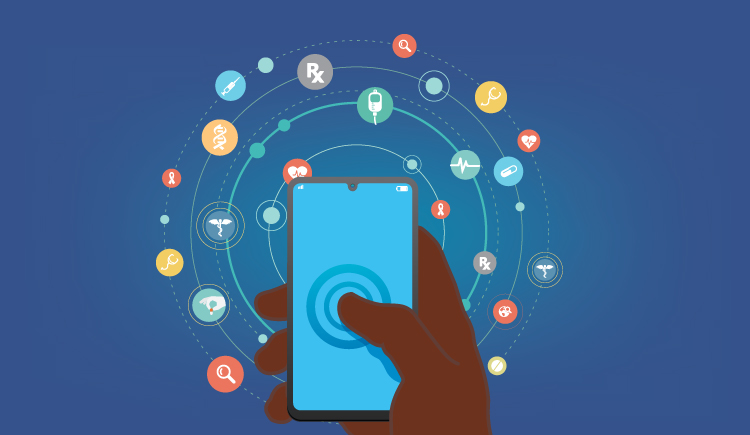A glimpse into the future of digital health innovation
Ted A. James, MD, MHCM, FACS, medical director at Beth Israel Deaconess Medical Center, discusses hurdles and solutions to adopting future digital health innovations.
Ted A. James, MD, MHCM, FACS, medical director at Beth Israel Deaconess Medical Center, discusses hurdles and solutions to adopting future digital health innovations.

A crystal ball is a handy instrument for anyone focused on the future. Decades ago, it could have forecast which digital health innovations would stick the landing. And it might have helped solve widely acknowledged challenges embedded in apps and tools that enable instantaneous sharing of medical information across the health ecosystem or between doctors and patients. Although every new technology has its hiccups, enormous value and excitement continues to drive the crowded field of digital health innovation. So, what distinguishes a winning innovation that genuinely helps solve problems from the many that will fail — or worse, create new problems?
Ted A. James, MD, MHCM, FACS, medical director and chief of breast surgical oncology at Beth Israel Deaconess Medical Center, focuses on improving quality in health care. He shares his ideas in greater detail in Harvard Medical School’s executive education program, Leading Digital Transformation in Health Care.
Edited and condensed for clarity
Digital health care plays a critical role in advancing the four pillars shaping the future of health care: patient experience, quality, affordability, and clinician well-being. But I believe its greatest potential lies in patient engagement.
I believe that digital health will be the driving force behind putting health care in the hands of patients. It can improve access, efficiency, and convenience while also empowering patients for self-care. I think digital innovation will fundamentally transform the face of health care, allowing for individualization in a way that will truly benefit our most important stakeholders: our patients.
There are many digital health apps that help patients manage chronic diseases by educating them on how to prevent complications and maintain health and well-being. For example, in the case of a chronic disease like diabetes, digital health apps can empower the patient to manage their condition more comprehensively by helping them track blood sugar, nutrition, exercise, and medications.
There is a wealth of literature and experience pointing to some common barriers in technology adoption, such as cost and regulatory requirements, whether they are FDA or HIPAA requirements. Interoperability is another area where people have encountered limiting forces in the spread of technology. And there are also impediments due to legitimate concerns about data security.
These barriers can be navigated by understanding the inner workings of the health care ecosystem. Gaining insight into the forces currently driving the future of health care, as well as the fundamental strategies that facilitate change, is critical for success.
People in health care are not so much resistant to change as they are resistant to uncertainty. If a new technology can demonstrate its value, fit into the work culture, and provide the necessary resources to be effective, that goes a long way in increasing adoption and implementation. It’s essential that technology be integrated in a way where it’s not a burden, but rather it actually facilitates getting tasks done efficiently.
The electronic health record (EHR) was one of the first examples of a digital health technology that carried tremendous promise to improve care. Unfortunately, it did not live up to those expectations. We need to improve EHRs to make them more user-friendly and seamless. I'm optimistic that we'll be able to do so in the coming iterations. Artificial intelligence, natural language processing, and medical algorithms are a few examples of potential EHR advancements. But even now, the ability to instantly retrieve the results of a patient's test that was performed six months ago at another hospital across town is a tremendous benefit.
Yes, the application of design thinking or biodesign concepts. The idea is to create products or services based on end-user insights and perspectives — in this case, the patients and physicians who use these products and services.
This approach has been employed effectively in a wide range of clinical settings, from patient health apps to medical devices. These are designed, developed, and implemented with the end user not just in mind but also fully collaborating and partnering in the development and implementation of products.
Many times, I think solutions are developed in isolation, and as a result, they do not exactly meet the needs of the critical event. There is also a lack of understanding about how best to implement an innovation. It’s essential to involve patients and physicians from the beginning and get multiple stakeholder analysis. Innovators must thoroughly understand the needs of the end users, as well as the environment in which these products and services are being used. This approach goes a long way toward having a solution that truly solves a major problem in patient care and fits well into the clinical workflow. If an innovation is embedded in the culture, it will be more successfully adopted.
— Francesca Coltrera
Continue the conversation by joining Ted A. James at the Leading Digital Transformation in Health Care program, or connect with us on Twitter @HMS_ExecEd or @tedjamesmd.
© 2025 by the President and Fellows of Harvard College